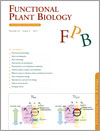
Functional Plant Biology
Volume 44 Number 2 2017
FP16184A pump/leak model of growth: the biophysics of cell elongation in higher plants revisited
Growth is an issue of central importance in plant physiology and agriculture. Growing cells expand by generating an internal hydrostatic pressure – the turgor. A thorough revision of over 40 years of research suggests that turgor results from a steady-state between passive water uptake via aquaporins driven by an osmotic gradient (which is generally accepted) and by a secondary active water secretion, including a cotransport of water and solutes.
FP15289Aluminium-inhibited NO3– uptake is related to Al-increased H2O2 content and Al-decreased plasma membrane ATPase activity in the root tips of Al-sensitive black soybean
The study on the effect of Al stress on the absorption of NO3– N in soybean could provide a scientific basis for N management in acid soil. The results showed that Al stress could significantly inhibit the absorption of NO3–N in soybean; however, Mg and ascorbic acid could reduce the inhibition of NO3– N uptake by Al stress. The inhibition of nitrate uptake in soybean in acid soil is expected to be alleviated by applying Mg and ascorbic acid.
FP16180The seed-borne Southern bean mosaic virus hinders the early events of nodulation and growth in Rhizobium-inoculated Phaseolus vulgaris L.
Seed-transmitted viruses are a major threat in tropical and subtropical fields, hindering the benefits of applying Rhizobium inoculants in legume crops. We developed an easy, 100% effective protocol to promote the infection of germinating seeds with a legume virus. This protocol will enable further research beyond our findings with Phaseolus vulgaris L. for improving cultural practices to reduce the incidence of viruses in tropical and subtropical legume crops.
FP16082Effects of drought stress on morphological, physiological and biochemical characteristics of wheat species differing in ploidy level
Modern polyploid wheat has diploid and tetraploid ancestors that may harbour beneficial drought resistance genes lost during domestication and subsequent breeding. We compared the morpho-physiological and biochemical responses to drought of eight accessions of wild and domesticated wheat differing in ploidy level, and show that modern polyploid wheat invests less biomass in roots and more in leaves and reproductive organs, particularly under drought.
FP16154Genotypic variation in soil water use and root distribution and their implications for drought tolerance in chickpea
Knowledge on soil water use pattern is critical for adapting chickpea to drought. Drought reduced surface root distribution while enhancing the deeper ones Water use from 15 to 30 and 90 to 120 cm soil depths were critical for best adaptation.
FP16154 Abstract | FP16154 Full Text | FP16154PDF (707 KB) | FP16154Supplementary Material (174 KB) Open Access Article
FP16263Assessing the suitability of various screening methods as a proxy for drought tolerance in barley
In a search for a convenient and rapid screening method for drought tolerance, barley genotypes were evaluated for a range of physiological and agronomical measures. Leaf chlorophyll fluorescence Fv/Fm ratio and the relative root growth rate of polyethylene glycol-treated seedlings were found to be the most suitable proxies for quantifying drought tolerance.
FP16189Warming alters the positive impact of elevated CO2 concentration on cotton growth and physiology during soil water deficit
Alterations in climate factors such as rising CO2 concentration ([CO2]), warming and reduced precipitation may have significant impacts on plant physiology and growth. Cotton was grown in the glasshouse at two [CO2] treatments (CA, 400 µL L–1; CE, 640 µL L–1) and two temperature treatments (TA, 28°C :17°C day : night; TE, 32°C : 21°C day : night), and subjected to two progressive water deficit cycles, with a 5-day recovery period between the water deficit periods. CE may provide positive growth and physiological benefits to cotton under TA if sufficient water is available but CE will not mitigate the negative effects of rising temperature on cotton growth and physiology in future environments.



